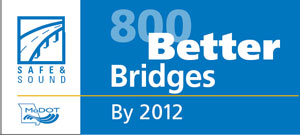
|
| (Image courtesy of Missouri DOT |
The Show-Me state's transportation agency wants to see what the private sector can to do to improve and maintain 800 structurally deficient bridges throughout the state. The Missouri Dept. of Transportation announced Sept. 7 a groundbreaking plan to award a design-build-maintain contract the statewide bridge inventory. The winning team will be responsible for rehabilitating or replacing all the bridges by 2012 and maintaining them for 25 years thereafter. MoDOT will pay the team annually based on the meeting of performance standards during that time.
Pete Rahn, managing director for MoDOT, says the contract will involve up to $600 million in design and construction. "What we intend to do is provide great flexibility in the design and construction. We will turn over a great deal of authority to the team to come up with economical solutions."
Rahn anticipates a draft request for proposals and request for qualifications around the first of October. "We hope to make a team selection by May," he says.
Don Hillis, MoDOT systems management director, says the bridge superstructures range from steel to concrete to timber and are on average about 40 years old. While still safe, they are structurally deteriorated to the point where many would have to be shut down within a couple of years, adds Rahn. "Lots of the problems are related just to wear and tear on the deck," says Hillis. "Chloride is wearing down bridge joints, and when these were being built 50 years ago we were not using epoxy rebar."
|
Rahn says the creation of the bridge program, dubbed Safe & Sound Bridge Improvement Plan came about because "we were making no significant headway" in keeping ahead of the rate of deterioration through the traditional funding program. "As quickly as we fix bridges, more fall into the deficient category," he says. "The only way to change that is to get in front of that curve. We can¹t get in front of it with a traditional solution."
The state Highways and Transportation Commission this summer had approved a Statewide Transportation Improvement Program budget of approximately $7.1 billion for fiscal years 2007 through 2011, including $5.7 billion for highway and bridge projects. The STIP provides for about 200 structurally deficient bridges, says Rahn. The design-build contract aims to take care of the rest.
The biggest challenge for the winning team will be that "we¹re not telling the team how to do this," Hillis says. "We want them to tell us." He says the program, the third of three design-build pilot projects allowed under current legislation. The other two are a $535-million 12-mile reconstruction of Interstate 64 and a $245-million 5-mile Northland Crossing from downtown Kansas City to Highway 210.
"It's still a learning curve for us," says Hillis. "In our typical design-bid-build process we would be intimately involved in the solution and the quality control/quality assurance."
In this case, MoDOT will expect the team to come up with means and methods, but will set performance criteria, including minimum bridge widths, loading levels and structural condition. MoDOT will inspect for performance criteria annually during the maintenance period and make payments accordingly.
None of the bridges are particularly large, nor lend themselves to toll revenue, says Rahn. "Some may have maybe 200 cars a day," he notes. "Any one bridge by itself doesn't rise to the level of critical -- but there are so many of them. It's the system that¹s critical."
Rahn is crossing his fingers that the industry will be prepared to take on this type and scope of contract. "It¹s going to challenge them to be economical, and drastically change their traditional approach to addressing a highway bridge.
He notes that as chief of the New Mexico DOT, competition was scarce for the 140-mile, four-lane widening of Highway 44 that included a 20-year, $60-million warranty from the developer-contractor. "When I did NM 44, we didn't know if the industry was ready for a project like that. But there was one," he recalls. "I hope it's a mature environment and as a result we'll secure multiple economical proposals."
 Related Links:
Related Links: 
